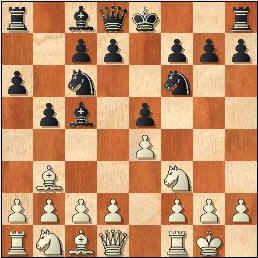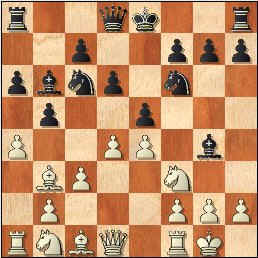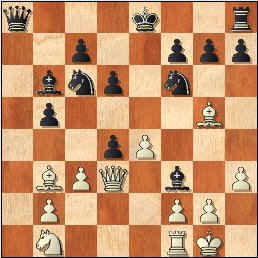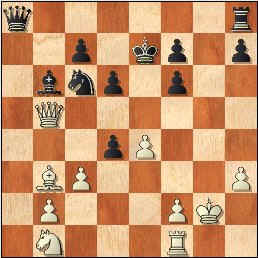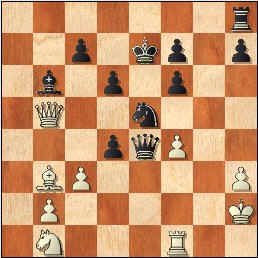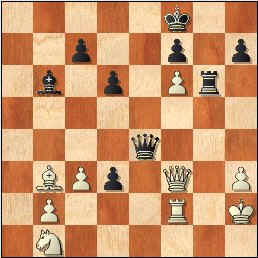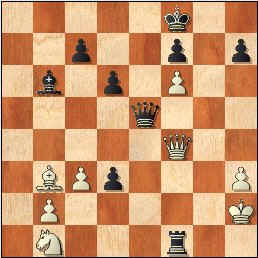All
the |
(Navigation bar
directly below.)
*******
© A.J. Goldsby, 2015.
(All rights reserved.)
****************
Click HERE
to see my
Chess Items.
****************
****************
Buy a book
from Amazon.com
(And help me out as well!)
****************
Click HERE
...
to see a list of the businesses that help to sponsor all of
my chess efforts.
CG
- "Problem of the Day"
(Friday; June 24th, 2011.)
Click HERE to see an explanation of the symbols that I commonly use when I annotate any chess game.
Click HERE to replay this game ... on another server.
GM Milos Pavlovic (2494) - GM
Magnus Carlsen (2625)
|
|
|
[A.J. Goldsby I]
The game for the POTD.
http://www.chessgames.com/perl/chessgame?gid=1400882
Friday; June 24th, 2011.
1.e4 e5;
2.Nf3 Nc6; 3.Bb5 a6; 4.Ba4 Nf6; 5.0-0 b5; 6.Bb3 Bc5;
The Arch-Angel, I have seen this a few times as White.
|
|
r1bqk2r/2pp1ppp/p1n2n2/1pb1p3/4P3/1B3N2/PPPP1PPP/RNBQ1RK1 w kq - 0 7
I have won a few times, but mostly
against players 2000 or below. In 2001, I got a draw (as White) against
FM Steven Muhammed;
(2475).
[Today, Steve is an IM.]
[ One popular reference gives the following continuation:
6...Bb7; 7.Re1 Bc5; 8.c3 d6;
9.d4 Bb6; 10.Be3 0-0;
11.Nbd2 h6; 12.h3,
"+/=" 12...Rb8;
and while White may have a small edge here, Black's
position is very playable.
An interesting contest would be:
Dmitrij Jakovenko (2627) -
Evgeny Tomashevsky (2555);
[C78] / 58th RUS-ch
[semi-finals] (R#3)
/ Kazan, RUS; 05,09,2005.
(White won, 1-0 in 61
moves. REPLAY
this game, on the CG site.)
[ (Initial source was MCO here.) See MCO-15, page # 66; column # 25,
and all
(applicable) notes. ] ]
7.c3 d6;
8.d4 Bb6; 9.a4, (Q-side play.)
A reasonable try, White does this in many variants of this system, the main thing is
(of course!) the timing of this particular pawn thrust.
[ Another line is: 9.Re1 0-0; "="
Andrei Istratescu (2602) -
Julian Sofronie (2436) [C78] /
1st Niort Open (R#7), 2004. (A short draw, 19 moves.)
]
9...Bg4;
(Maybe - '!?')
This seems a little different, most games that I have looked at, Black puts the QB (LSB) on b7,
when the second player has two pieces striking at the WK.
|
|
r2qk2r/2p2ppp/pbnp1n2/1p2p3/P2PP1b1/1BP2N2/1P3PPP/RNBQ1RK1 w kq - 0 10
However - I must stress while this move, (9...Bg4); may not be a "main line," it is far from being unplayable ... in fact, Black does quite good with this B-pin here!
10.axb5,
(Pawn structure.)
White goes for simplifications, but this seems to mostly help Black - at least the way that
the game turned out.
[ Probably better was: >/= 10.Bg5, "+/="
when several engines that I tested show
an edge here for White. ]
10...axb5;
11.Rxa8 Qxa8; 12.h3 Bh5; 13.Qd3!?,
Perhaps an attempt to stir things up (by White).
[ Maybe better for White was:
13.d5 Na5; "~" with roughly
an equal game. ]
Now complications flare up ...
13...exd4; 14.Bg5 Bxf3;
So far, play has been without any significant errors.
|
|
q3k2r/2p2ppp/1bnp1n2/1p4B1/3pP3/1BPQ1b1P/1P3PP1/1N3RK1 w k - 0 15
White has entered into early and
vague complications ...
15.Bxf6?,
(error/mistake)
This turns out poorly for White, simply taking with the WQ looked to be much better than this.
[ White should have played: >/= 15.Qxf3 Ne5;
"="
when it looks equal, maybe a fuzz better for Black.
]
(In the following line, 16.Bxg7,
is unacceptable; look at the simple move 16...Bxf1; for Black.)
15...Bxg2!; 16.Kxg2 gxf6; 17.Qxb5 Ke7;
"+/=" (Maybe "/+")
The dust has settled, Black has a clear advantage here.
|
|
q6r/2p1kp1p/1bnp1p2/1Q6/3pP3/1BP4P/1P3PK1/1N3R2 w - - 0 18
Both Kings are a little uncomfortable, although I would have to say that White's King is worse off than Black's.
18.Kh2 Ne5;
19.f4 Qxe4!!;
A nice combination, this is far from being "an easy win" here, Black had to do a lot of good,
concrete calculations to be sure that this sacrifice would work.
|
|
7r/2p1kp1p/1b1p1p2/1Q2n3/3pqP2/1BP4P/1P5K/1N3R2 w - - 0 20
The opening is barely over, and now Black invests a piece, in order to get after the White King.
[ Or Black could have tried: RR19...Ng6!; 20.Qe2 Qc6; "/+" with a clear edge. ]
20.fxe5?!,
(Maybe even - '?')
This turns out to be another error for White. Better was Nd2, although analysis will show that
White probably could not save his game.
[ The box suggests a line which is extremely complicated, e.g.:
>/= 20.Nd2 Qe3; 21.fxe5 Rg8;
22.exd6+ Kf8; 23.Ne4 Qxe4;
24.Rf2 Qe3;
25.Qf1 Qe5+; 26.Kh1 dxc3; 27.d7 Ke7;
28.Re2 Be3;
29.d8Q+ Kxd8; "-/+" and Black will win from here. ]
The next few moves look to
be forced for both sides.
20...Rg8!; 21.exf6+ Kf8; 22.Rf2 d3; 23.Qh5 Rg6!; 24.Qf3,
hmmm (Forced!?)
The box wants to toss a whole Rook here, most humans would resign before playing that.
|
|
5k2/2p2p1p/1b1p1Pr1/8/4q3/1BPp1Q1P/1P3R1K/1N6 b - - 0 24
We now have reached our position for the Problem of the Day.
[ IF White wanted to play on, he had to play: >/= 24.Qd5T, - Fritz 12
(Black wins easily by trading the Queens - than munching
the Rook on f2.) ]
A (younger) Carlsen now finishes
off his opponent - in fine style.
24...Qe5+!; 25.Kh1,
There isn't much that is good here for White ...
[ Or (White could have played):
25.Qf4 Qe1; 26.Rg2 Bg1+; 27.Kh1 Be3+;
"-/+"
and Black wins the WQ. ]
25...Qe1+;
26.Rf1[],
This is forced.
[ </= 26.Kh2? Qg1#. ]
26...Rg1+!;
27.Kh2[],
Again, White has no choice.
[ </= 27.Rxg1? Qxg1#. ]
27...Qe5+!;
28.Qf4 Rxf1; "-/+"
The game is now over, although White waits until he is down even more material - before he resigns.
|
|
5k2/2p2p1p/1b1p1P2/4q3/5Q2/1BPp3P/1P5K/1N3r2 w - - 0 29
29.Qxe5 dxe5;
30.Nd2 Rf2+; 31.Kg3 Rxd2; 32.Bxf7 Kxf7; 33.b4 Rf2; White Resigns.
An excellent game by Magnus Carlsen, who played sharp chess and won a fine effort against a
near 2500 opponent.
Copyright (c) A.J. Goldsby, 2011. All rights reserved.
0 - 1
Nice blog on this web-page.
The analysis for this page was prepared with the excellent program, ChessBase 10.0. (My main engine was Fritz 12.)
The HTML was polished with several different tools and programs, (mostly FP) ... the text was checked for spelling with MS Word.
The diagrams were created with the program, Chess Captor 2.25.
|
Go ... or return ... to my Home Page for this site. Go (or return) ... to my "Annotated Games" (II) Page. Go
... or return ... to my "Best Games" Page. *******
Copyright (c)
LM A.J. Goldsby
I ******* This page was first generated in: June, 2011. (Posted on: June 24th, 2011.) This game was last edited, altered or saved on: May 10, 2014 06:04 AM . |
